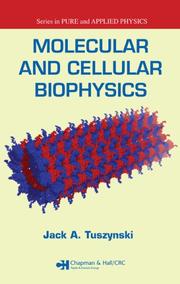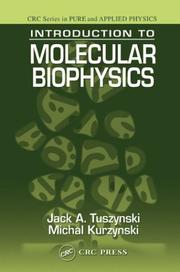| Listing 1 - 9 of 9 |
Sort by
|

ISBN: 9781584886754 9781420011722 1584886757 Year: 2008 Publisher: Boca Raton, Fla Chapman & Hall/CRC
Abstract | Keywords | Export | Availability | Bookmark
 Loading...
Loading...Choose an application
- Reference Manager
- EndNote
- RefWorks (Direct export to RefWorks)
"From quantum theory to statistical mechanics, the methodologies of physics are often used to explain some of life's most complex biological problems. Exploring this challenging yet fascinating area of study, Molecular and Cellular Biophysics covers both molecular and cellular structures as well as the biophysical processes that occur in these structures. The book features a quantitative approach that avoids being too abstract in its presentation." "Logically organized from small-scale (molecular) to large-scale (cellular) systems, the text first defines life, discussing the scientific controversies between mechanists and vitalists, the characteristics of living things, and the evolution of life. It then delves into molecular structures, including nucleic acids, DNA, RNA, interatomic interactions, and hydrogen bonds. After looking at these smaller systems, the author probes the larger cellular structures. He examines the cytoplasm, the cytoskeleton, chromosomes, mitochondria, motor proteins, and more. The book concludes with discussions on biophysical processes, including oxidative phosphorylation, diffusion, bioenergetics, conformational transitions in proteins, vesicle transport, subcellular structure formation, and cell division."--Jacket.
General biophysics --- Biophysics --- Molecular biology --- Molecular Biology --- 576.32 --- 576.32 Mechanical activity of the cell --- Mechanical activity of the cell --- Biochemical Genetics --- Biology, Molecular --- Genetics, Biochemical --- Genetics, Molecular --- Molecular Genetics --- Biochemical Genetic --- Genetic, Biochemical --- Genetic, Molecular --- Molecular Genetic --- Genetic Phenomena --- Mechanobiology --- Molecular biochemistry --- Molecular biophysics --- Biochemistry --- Biomolecules --- Systems biology --- Biological physics --- Biology --- Medical sciences --- Physics --- Molecular biology.
Digital
ISBN: 9783540367239 Year: 2006 Publisher: Berlin Springer-Verlag
Abstract | Keywords | Export | Availability | Bookmark
 Loading...
Loading...Choose an application
- Reference Manager
- EndNote
- RefWorks (Direct export to RefWorks)
Philosophy --- Quantum mechanics. Quantumfield theory --- Physics --- Physiology of nerves and sense organs --- Neuropathology --- quantumfysica --- neurologie --- filosofie --- fysica --- neurobiologie

ISBN: 0849300398 9780849300394 Year: 2003 Publisher: Boca Raton (Fla.): CRC,
Abstract | Keywords | Export | Availability | Bookmark
 Loading...
Loading...Choose an application
- Reference Manager
- EndNote
- RefWorks (Direct export to RefWorks)
General biophysics --- Molecular biology --- Biophysics --- 577.32 --- Molecular biophysics --- 577.32 Molecular biophysics --- Molecular Biology --- Molecular biochemistry --- Biochemistry --- Biomolecules --- Systems biology --- Biological physics --- Biology --- Medical sciences --- Physics --- Molecular biology.
Digital
ISBN: 9783540748915 Year: 2008 Publisher: Berlin, Heidelberg Springer-Verlag
Abstract | Keywords | Export | Availability | Bookmark
 Loading...
Loading...Choose an application
- Reference Manager
- EndNote
- RefWorks (Direct export to RefWorks)
Biomathematics. Biometry. Biostatistics --- Genetics --- General biophysics --- Human genetics --- biofysica --- medische genetica --- proteomics --- bio-informatica --- genetica --- biometrie --- proteïnen
Book
ISBN: 9783540367239 Year: 2006 Publisher: Berlin Heidelberg Springer Berlin Heidelberg
Abstract | Keywords | Export | Availability | Bookmark
 Loading...
Loading...Choose an application
- Reference Manager
- EndNote
- RefWorks (Direct export to RefWorks)
Consciousness remains one of the major unsolved problems in science. How do the feelings and sensations making up conscious experience arise from the concerted actions of nerve cells and their associated synaptic and molecular processes? Can such feelings be explained by modern science, or is there an entirely different kind of explanation needed? And how can this seemingly intractable problem be approached experimentally? How do the operations of the conscious mind emerge out of the specific interactions involving billions of neurons? This book seeks answers to these questions on the underlying assumption that consciousness can be understood using the intellectual potential of modern physics and other sciences. There are a number of theories of consciousness, some based on classical physics while others require the use of quantum concepts. The latter ones have drawn criticism from the parts of the scientific establishment while simultaneously claiming that classical approaches are doomed to failure. The contributing authors present a spectrum of opinions from both sides of this on-going scientific debate, allowing readers to decide for themselves which of the approaches are most likely to succeed.
Philosophy --- Quantum mechanics. Quantumfield theory --- Physics --- Physiology of nerves and sense organs --- Neuropathology --- quantumfysica --- neurologie --- filosofie --- fysica --- neurobiologie
Book
ISBN: 9783540748908 9783540748915 Year: 2008 Publisher: Berlin Heidelberg Springer Berlin Heidelberg
Abstract | Keywords | Export | Availability | Bookmark
 Loading...
Loading...Choose an application
- Reference Manager
- EndNote
- RefWorks (Direct export to RefWorks)
This monograph addresses, in a systematic and pedagogical manner, the mathematical methods and the algorithms required to deal with the molecularly based problems of bioinformatics. The book will be useful to students, research scientists and practitioners of bioinformatics and related fields, especially those who are interested in the underlying mathematical methods and theory. Among the methods presented in the book, prominent attention is given to pair-wise and multiple sequence alignment algorithms, stochastic models of mutations, modulus structure theory and protein configuration analysis. Strong links to the molecular structures of proteins, DNA and other biomolecules and their analyses are developed. In particular, for proteins an in-depth exposition of secondary structure prediction methods should be a valuable tool in both molecular biology and in applications to rational drug design. The book can also be used as a textbook and for this reason most of the chapters include exercises and problems at the level of a graduate program in bioinformatics.
Multi
ISBN: 9783031237171 9783031237164 9783031237188 9783031237195 Year: 2023 Publisher: Cham Springer International Publishing :Imprint: Springer
Abstract | Keywords | Export | Availability | Bookmark
 Loading...
Loading...Choose an application
- Reference Manager
- EndNote
- RefWorks (Direct export to RefWorks)
This book is a collection of stories, reflections and advice written by proficient scientists. They address the question of what doing science means to them, and describe attitudes and working practices that have proved effective and rewarding. The book is aimed in particular at young people who are attracted by science or already undertaking undergraduate studies, and who are considering making science their long-term profession. It will also be helpful and revealing to early-career scientists who are searching for their own best route to success. The book serves as a platform for experienced scientists to describe their original inclination, how that subjective disposition found its expression in their way of doing science, whether their expectations were met, and what achievements they can claim. But it is not restricted to success: contributors also share details of the limitations and failures they have encountered. Last but not least they describe how they see science now, how they think it will be in the near future, and what advice they would give to the their much younger colleagues. Readers will appreciate the diversity of the individual paths shaped by different education, motivation, ambition, inclination, intuition, feeling, belief and eligibility. At the same time the stories confirm that science relies on a translation of this subjective level into an objective level, one that is shared and accepted by the international scientific community, and whose results are produced with a commonly accepted and fully rational scientific method of investigation.
Science --- Philosophy of science --- kritisch denken --- onderzoeksmethoden --- wetenschapsfilosofie
Book
ISBN: 9783642035845 9783642261978 9783642036217 9783642035838 Year: 2010 Publisher: Berlin Heidelberg Springer Berlin Heidelberg
Abstract | Keywords | Export | Availability | Bookmark
 Loading...
Loading...Choose an application
- Reference Manager
- EndNote
- RefWorks (Direct export to RefWorks)
Nanoneuroscience is the study of computationally relevant biomolecules found inside neurons. Because of recent technological advances at the nanometer scale, scientists have at their disposal increasingly better ways to study the brain and the biophysics of its molecules. This book describes how biomolecules contribute to the operations of synapses and perform other computationally relevant functions inside dendrites. These biomolecular operations considerably expand the brain-computer analogy - endowing each neuron with the processing power of a silicon-based multiprocessor. Amazingly, the brain contains hundreds of billions of neurons.
General biophysics --- Human biochemistry --- Physiology of nerves and sense organs --- Electrical engineering --- Biotechnology --- medische biochemie --- biofysica --- nanotechniek --- bio-engineering --- biotechnologie --- neurobiologie
Digital

ISBN: 9783540896548 Year: 2009 Publisher: Berlin, Heidelberg Springer Berlin Heidelberg
Abstract | Keywords | Export | Availability | Bookmark
 Loading...
Loading...Choose an application
- Reference Manager
- EndNote
- RefWorks (Direct export to RefWorks)
Science --- Philosophy --- Quantum mechanics. Quantumfield theory --- quantumfysica --- popularisering wetenschap --- filosofie
| Listing 1 - 9 of 9 |
Sort by
|

 Search
Search Feedback
Feedback About UniCat
About UniCat  Help
Help News
News